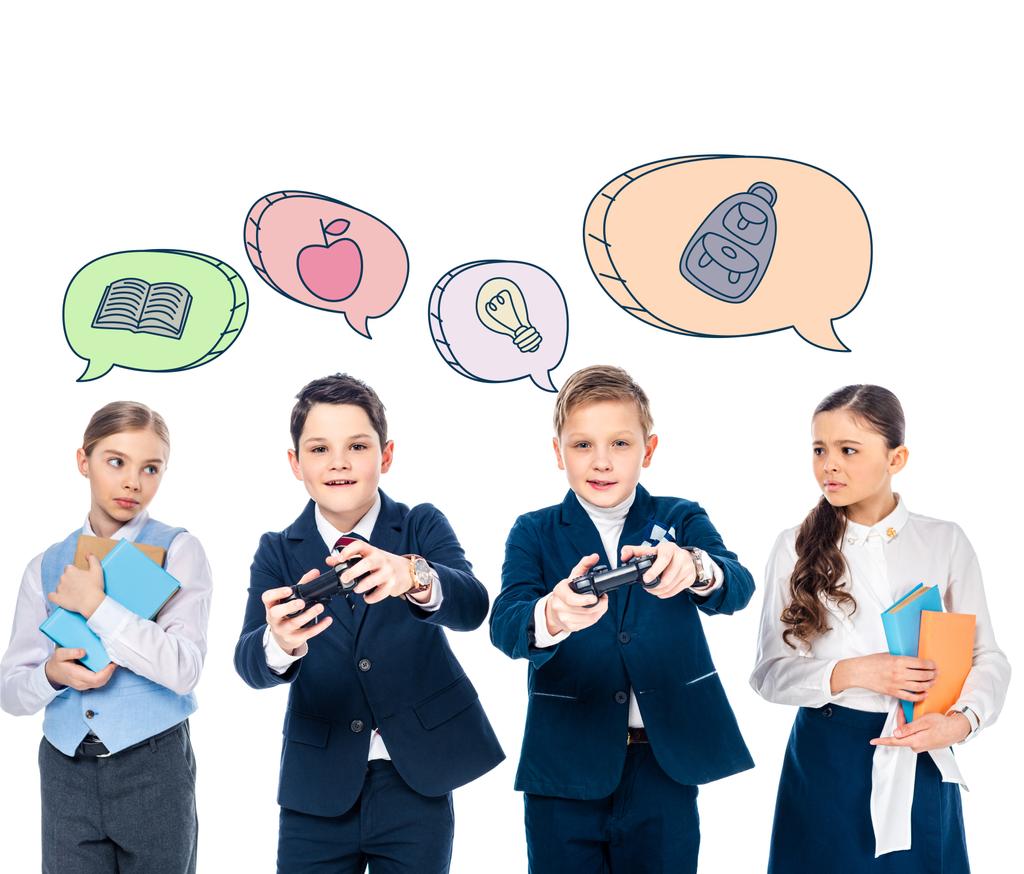Discover a comprehensive step-by-step guide on teaching public speaking to 10-11 year olds.
Teaching Public Speaking to 10-11 Year Olds: A Step-by-Step Guide
In today’s fast-paced world, public speaking skills have become more important than ever. The ability to confidently express oneself in front of an audience is a valuable asset that can open countless doors in both personal and professional life. And what better time to start developing these skills than during childhood? In this step-by-step guide, we will explore the ins and outs of teaching public speaking to 10-11 year olds, helping them build confidence, overcome fear, and deliver captivating speeches.

Understanding the Importance of Public Speaking Skills
Public speaking is not just about giving formal speeches on stage. It is a skill that goes beyond classrooms and podiums, influencing various aspects of a child’s life. Learning to express thoughts and ideas effectively helps children develop crucial communication skills, boosts self-confidence, and enhances critical thinking abilities.
Moreover, public speaking cultivates empathy and understanding as students learn to connect with their audience, listen attentively, and deliver powerful messages that resonate. These skills are essential for building relationships, creating positive change, and becoming effective leaders in the future.
When children engage in public speaking, they are not only learning to articulate their thoughts but also developing their ability to think on their feet. They learn to analyze situations quickly, organize their ideas coherently, and respond to questions or challenges with clarity and confidence. These skills are invaluable in various professional settings, such as job interviews, presentations, and team collaborations.
Furthermore, public speaking provides children with a platform to share their unique perspectives and experiences. By expressing themselves authentically, they learn to embrace their individuality and celebrate their voice. This fosters a sense of self-worth and empowers them to stand up for what they believe in.
The Role of Public Speaking in Child Development
Public speaking plays a significant role in the holistic development of children. It fosters social skills, teaches empathy, and enhances emotional intelligence. By expressing themselves in a confident and articulate manner, children learn to navigate social situations, resolve conflicts, and better understand the perspectives of others. These invaluable life skills will serve them well in all aspects of their lives.
Moreover, public speaking encourages children to become active listeners. They learn to pay attention to the needs and interests of their audience, adapting their message accordingly. This ability to empathize and connect with others is crucial in building meaningful relationships and fostering a sense of community.
Additionally, public speaking provides children with a platform to explore different topics and expand their knowledge. Through research and preparation, they delve into various subjects, gaining a deeper understanding of the world around them. This not only enhances their intellectual growth but also nurtures their curiosity and love for learning.
Furthermore, public speaking allows children to develop their creativity and storytelling skills. They learn to captivate their audience through engaging narratives, vivid descriptions, and compelling anecdotes. This ability to communicate effectively through storytelling is a valuable asset in many professions, such as marketing, journalism, and entertainment.
Overcoming Fear and Building Confidence in Young Speakers
Public speaking can be daunting, especially for young children who may feel shy or anxious about speaking in front of others. As educators, it is crucial to create a safe and encouraging environment where students feel supported to conquer their fears and build self-confidence. By providing positive feedback, celebrating small victories, and offering constructive guidance, we can empower young speakers to embrace their unique voices and become fearless communicators.
Furthermore, public speaking offers children a chance to overcome their fear of failure. By taking risks and stepping out of their comfort zones, they learn that making mistakes is a natural part of the learning process. This resilience and ability to bounce back from setbacks are essential life skills that will serve them well in any endeavor they pursue.
Moreover, public speaking provides children with a platform to receive recognition and validation for their efforts. When they receive applause and positive feedback from their peers and teachers, it boosts their self-esteem and motivates them to continue improving their skills. This positive reinforcement creates a cycle of growth and self-belief, empowering young speakers to reach their full potential.
In conclusion, public speaking is a transformative skill that goes beyond the act of speaking itself. It shapes children into confident, empathetic, and articulate individuals who can effectively communicate their ideas, connect with others, and make a positive impact on the world.
Setting the Stage for Public Speaking
Before diving into the technicalities of public speaking, it is essential to create an environment that sets the stage for success. This involves creating supportive structures and emphasizing the value of the audience’s role in the speaking process.
Creating a Safe and Encouraging Environment
Building trust and fostering a safe space for expression is paramount when teaching public speaking to 10-11 year olds. Encourage students to share their thoughts, opinions, and ideas without judgment. Respect their individuality and create an atmosphere where mistakes are seen as learning opportunities. This nurturing environment will allow students to feel comfortable stepping out of their comfort zones and exploring their potential as speakers.
Within this safe and encouraging environment, it is important to establish clear guidelines for respectful communication. Teach students the importance of active listening and constructive feedback. Encourage them to support and uplift one another, creating a sense of camaraderie within the class. By fostering a positive and inclusive atmosphere, students will feel more motivated and confident in their public speaking endeavors.
Furthermore, it is crucial to provide ample opportunities for practice and growth. Create a schedule that allows students to regularly engage in public speaking exercises, such as impromptu speeches or small group discussions. Provide constructive feedback and encourage students to reflect on their progress. By consistently challenging themselves and receiving guidance, students will develop their speaking skills and gain confidence over time.
The Importance of Audience in Public Speaking
Emphasize the significance of the audience in public speaking. Explain to students that their speeches have the power to impact, inspire, and entertain others. Encourage active listening and provide guidance on how to effectively engage with the audience. Teach students to consider the interests, needs, and knowledge levels of their listeners when crafting their speeches. By understanding the importance of the audience, young speakers will be motivated to deliver well-prepared and engaging presentations.
To further highlight the role of the audience, introduce students to the concept of empathy. Explain that effective public speakers are able to connect with their audience on an emotional level, understanding their perspectives and experiences. Encourage students to research and gather information about their audience beforehand, enabling them to tailor their speeches accordingly. By demonstrating empathy and catering to the needs of their listeners, students will be able to establish a stronger connection and leave a lasting impact.
In addition, discuss the concept of non-verbal communication with students. Teach them about the importance of body language, facial expressions, and vocal tone in conveying their message effectively. Encourage students to practice maintaining eye contact, using appropriate gestures, and modulating their voice to engage the audience. By mastering these non-verbal communication skills, students will enhance their overall delivery and captivate their listeners.
Lastly, highlight the value of feedback from the audience. Teach students to actively seek feedback after their speeches, whether through formal evaluations or informal discussions. Emphasize the importance of listening to the perspectives of others and using feedback as a tool for improvement. By valuing the opinions of their audience, students will continuously refine their public speaking skills and become more effective communicators.
Basic Principles of Public Speaking for Kids
Now that we have set the stage, let’s explore some fundamental principles that will lay the foundation for excellent public speaking skills in 10-11 year olds.
Articulation and Voice Modulation Techniques
Clear and articulate speech is essential for effective communication. Encourage students to practice enunciation and pronunciation exercises to crisp up their speech. Additionally, teach them voice modulation techniques, such as varying pitch, volume, and pace, to add emphasis and captivate the audience. Role-playing activities can be a fun way to practice these skills and help students develop confidence in expressing themselves.
The Power of Body Language and Gestures
Effective speakers understand that words alone are not enough; body language and gestures play a crucial role in conveying messages. Guide students to be mindful of their facial expressions, posture, and hand movements while speaking. Teach them how to use gestures effectively to support their words, enhancing the impact of their speeches. For instance, practicing speeches in front of a mirror or recording videos for self-evaluation can be useful exercises to improve body language awareness.
Structuring a Speech: A Guide for Kids
Now that students have learned some essential speaking techniques, it’s time to delve into the art of structuring a speech effectively.
Choosing the Right Topic
Help students select topics that they are genuinely interested in and passionate about. By choosing subjects close to their hearts, young speakers will be more motivated to research and prepare engaging speeches. Offer guidance in narrowing down broad topics and brainstorming ideas to develop winning content.
Organizing Thoughts and Ideas
Teach students the importance of organizing their thoughts into an engaging narrative structure. Encourage them to outline their speeches, using logical and coherent transitions between different points. Help students understand the significance of introduction, body, and conclusion in a speech, guiding them on how to engage the audience from the start, deliver impactful content, and leave a lasting impression.
Practical Public Speaking Activities for 10-11 Year Olds
Learning public speaking doesn’t have to be dull and monotonous. Incorporate fun and engaging activities into your lessons to make the learning process enjoyable for students.

Fun and Engaging Speech Exercises
Organize speech exercises such as impromptu speeches, where students have to think on their feet and deliver spontaneous speeches on given topics. This activity will help them build confidence in expressing their thoughts on the spot. Another idea is to have a debate or mock trial, where students can argue their points convincingly and develop critical thinking and persuasive skills.
Role-Playing and Improvisation Games
Engage students in role-playing scenarios that require public speaking skills, such as interviewing a famous historical figure or giving a speech as a fictional character. This will allow students to explore different perspectives, think creatively, and improve their ability to adapt and think on their feet. Improvisation games, where students have to spontaneously create stories or dialogues, can also boost confidence and fluency in spoken communication.
By following this step-by-step guide, you can empower 10-11 year olds to become confident speakers and effective communicators. Public speaking is a lifelong skill that will benefit them in countless ways as they navigate the challenges and opportunities that lie ahead. So, let’s dive in, have fun, and watch our young speakers shine on the stage!



